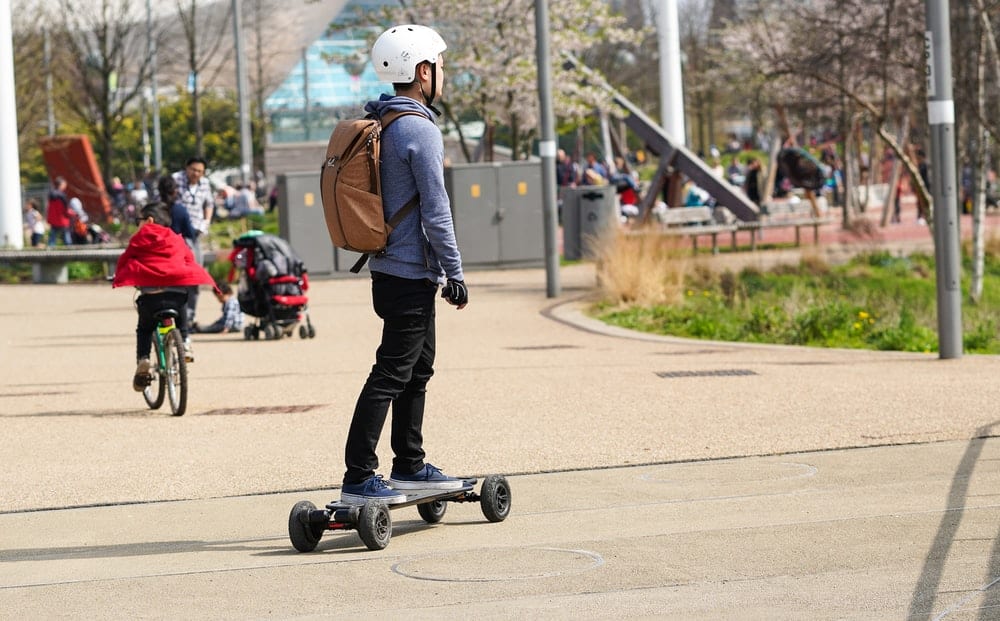There’s no way we can sit here and tell you that electric skateboards are 100% safe. Like any skateboard, if you’re going to build up speed on a plank of wood with no protection, you are going to be at some risk to your safety. Electric skateboards are in some ways safer than traditional boards, but they’re less safe in others.
Although traditional boards don’t have brakes at the flick of a trigger, they are less likely to fail on you. In fact, one of our top tips is to earn some basic skateboarding techniques for those ‘just in case’ moments. Top electric skateboards also have a higher top speed so that carries with it greater risk.

If you wanted a common factor that accidents on either device share however, user error will feature quite prominently. Both are dangerous to an extent by their nature, but the risks can be negated by proper use, research and skill. Let’s face it: on a non-electric board, you’ll have fewer concerns for Tony Hawk rattling downhill at 40kmph than you would your 8-year-old son. And the same applies here. Keep reading and we’ll cover the risks and what you can do to make sure you’re properly protected, so you can concentrate on enjoying your electric skateboarding in safety.
Are Electric Skateboards Dangerous?
Well, yes, in the wrong hands an electric skateboard can definitely be a risk to safety. Like normal skateboards, there are a number of ways you can do yourself some real damage if you’re not careful and properly protected. However, used right they’re incredibly fun, and a lightweight, economical and eco-friendly form of transport. So what can go wrong? Well, the most obvious risk is falling. Just like it’s non-electric cousin, the electric skateboard offers no protection at all from collisions and is very easy to fall off. To compound matters, just like inline-skating, road-cycling and longboarding, these things will only run on smooth hard surfaces. Which means if you do fall off, you’re landing hard on the concrete. Keeping your electric skateboard charged and having the battery in tip-top condition will also ensure that you avoid accidents or battery failure. The most common injuries reported whilst electric skateboarding are relatively minor, with cuts, abrasions and bruises topping the list. Not ideal, but to be expected. Slightly more serious injuries include those to the hand, wrist and arm, which normally occur as the rider attempts to break their fall.

Protective Gear
Wear a Helmet
Pads
You can save yourself a lot of pain and suffering by wearing knee pads and elbow pads. Hitting concrete at speed can cause cuts and abrasions, and the knees and elbows always get it the worst because they stick out. But if you’ve already covered up, that’s one less thing to worry about.
It’s not just cuts and bruises you need to prevent though: a direct hit on a knee or elbow at speed could actually break the boned in the joint and/or damage the ligaments, which will mean no more boarding for you for a while. So if you want to make sure you can get the most out of your board, wear some pads and protective gear and stay out of the hospital.

Know Your Level
By far the greatest contributory factor to the electric skateboarding injury stats is user error. And normally, this means running before you can walk. Of course, we understand that you’re going to want to get stuck in and go as fast as you can at first. But it’s worth remembering that it only takes one big off, and you won’t be going anywhere fast. For a while. So knowing your level is crucial.
If you’ve never ridden a board before, you need to be a little bit patient and learn how to properly control it before you start setting any land speed records. At top speed, learning how to control speed wobbles is another great way of keeping yourself off the pavement.
Practice

Choose Your Spots
Uneven surfaces are now your enemy, and so you have no excuse if a pothole puts you on the pavement. You will need to pick your spots carefully to make sure there aren’t any hidden dangers lurking. This generally means large open expanses of concrete – the kind of place you see skateboarders. It also means, at first, finding somewhere with few obstacles and other people you can collide with. If you’re planning to use your electric skateboard to commute, properly planning your route to avoid traffic hotspots and poor pavements is essential for your personal safety.
Do Electric Skateboards Have Brakes?

What is the Safest Electric Skateboard?
We hope we’ve shown you that electric skateboards are safe so long as they are used properly. By picking the right board even if you’re looking to buy budget electric skateboards, and making sure you are properly protected with a helmet and pads, you should be safe with a little practice. The safest electric skateboard is one that is used properly, period. So with a little practice and care, you could soon be riding an electrical skateboard as safely as possible. Not to mention having the time of your life in the process!

